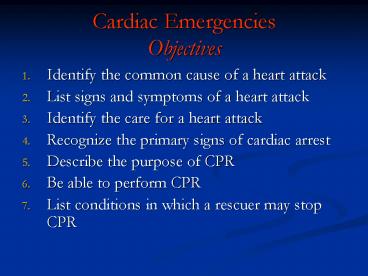Cardiac Emergencies Objectives - PowerPoint PPT Presentation
1 / 10
Title:
Cardiac Emergencies Objectives
Description:
Drowning, suffocation, ... This irreversible damage caused by brain cell death ... Compress chest about 2 inches Compress at a rate of at least 100 times/min Infant ... – PowerPoint PPT presentation
Number of Views:70
Avg rating:3.0/5.0
Title: Cardiac Emergencies Objectives
1
Cardiac EmergenciesObjectives
- Identify the common cause of a heart attack
- List signs and symptoms of a heart attack
- Identify the care for a heart attack
- Recognize the primary signs of cardiac arrest
- Describe the purpose of CPR
- Be able to perform CPR
- List conditions in which a rescuer may stop CPR
2
Heart Attack
- Like all living tissue, the cells of the heart
need a continuous supply of oxygen. The coronary
arteries supply the heart muscle with oxygen-rich
blood. If the heart is deprived of this blood, it
dies. - If enough of the muscle dies, the heart cannot
circulate blood effectively, causing a heart
attack. - A heart attack interferes with the hearts
electrical and mechanical systems. This
interference may result in an irregular
heartbeat, which may prevent blood from
circulating effectively.
3
Common Cause of a Heart attack
- A Heart attack is usually the result of
cardiovascular disease (coronary heart disease). - This is the leading cause of death for adults
over 44 years of age in the U.S. - 70 million Americans suffer from this.
- 1 million deaths annually/500,000 are due to
heart attacks - Cardiovascular disease develops slowly. Fatty
deposits of cholesterol and other material may
gradually build up on the inner walls of the
arteries.
4
Signs and Symptoms
- Persistent chest pain or discomfort, sometimes
confused with indigestion, (a muscle spasms) - Heart burn to unbearable crushing pain
- Breathes noisily, short of breath, faster than
normal - Skin ashen, pale, bluish - profuse sweating
- Nausea/vomit
5
Care for a Heart attack
- Recognize the signs and symptoms of a heart
attack - Call EMS
- Convince the victim to stop activity and rest
- Help the victim rest comfortably
- Comfort victim
- Assist the victim with medication, if prescribed
(Nitroglycerin - vasodilator) - Be prepared to give CPR if the victims heart
stops beating.
6
Cardiac Arrest/Common Causes
- Cardiac arrest occurs when the heart stops
beating or beats too ineffectively to generate a
pulse and blood cannot be circulated. - Cardiovascular disease is the most common.
- Drowning, suffocation, and certain drugs can
cause breathing to stop, which will soon lead to
cardiac arrest. - Severe injuries to the chest or severe blood loss
can also cause the heart to stop. - Electrocution disrupts the hearts electrical
activity - Stroke or other types of brain damage can also
stop the heart
7
Purpose of CPR
- A victim who is not breathing and has no pulse is
said to be clinically dead. However, the cells
of the brain and other vital organs will continue
to live for a short period of time until oxygen
is depleted. This victim needs cardiopulmonary
resuscitation (CPR) - Without CPR, the brain will begin to die within 4
to 6 minutes. This irreversible damage caused by
brain cell death is known as biological death.
8
Adult/Child CPR
- After doing the primary survey and you discover
the victim is not breathing and does not have a
pulse, begin CPR. - 30 compressions/2 breaths
- Adult - Compress chest at least 2 inches
- Child Compress chest about 2 inches
- Compress at a rate of at least 100 times/min
9
Infant CPR
- Infant
- Maintain head-tilt with hand on forehead
- Place pads of fingers below imaginary line
running across chest connecting nipples. Relax
your fingers. - 30 compressions/2 breaths
- Compress chest about 1 ½ inches
- Compress at a rate of 100 times/ min
10
Do Not Stop CPR unless
- You see an obvious sign of life such as
breathing. - An AED is ready to use.
- Another trained responder or EMS personnel take
over. - You are too exhausted to continue.
- The scene becomes unsafe.































